1990 VOLVO 240 oil capacity
[x] Cancel search: oil capacityPage 8 of 143

Volvo 1990 240 Model
A Clock
B Direction indicator (green)
C Speedometer
In kilometers and miles per hour (U.S. models)
In kilometers per hour (Canadian models)
D Odometer
Total reading in miles (U.S. models)
Total reading in kilometers (Canadian models)
E Temperature gauge
The gauge pointer should remain inside the black range during normal \
operation.
If the pointer enters the red range repeatedly, check coolant level a\
nd fan belt tension. (See sections
titled "Cooling system and coolant") Warning: allow engine to cool before adding
fluid.
Do not continue to drive the car with the pointer in the red zone.
F Fuel gauge
The fuel tank capacity is approx 60 liters = 15.8 US gals. See "Fuel \
requirements".
G Clock reset knob
H Service reminder light
I Check engine (red)
J Alternator warning light (red)
K Oil pressure warning light (red)
Do not drive the car with this light on.
L SRS (Supplemental Restraint System)
M Trip odometer reset knob Push in to reset
file:///K|/ownersdocs/1990/1990_240/90240_01.htm (4 of 5)12/30/2006 8:\
25:01 AM
Page 82 of 143
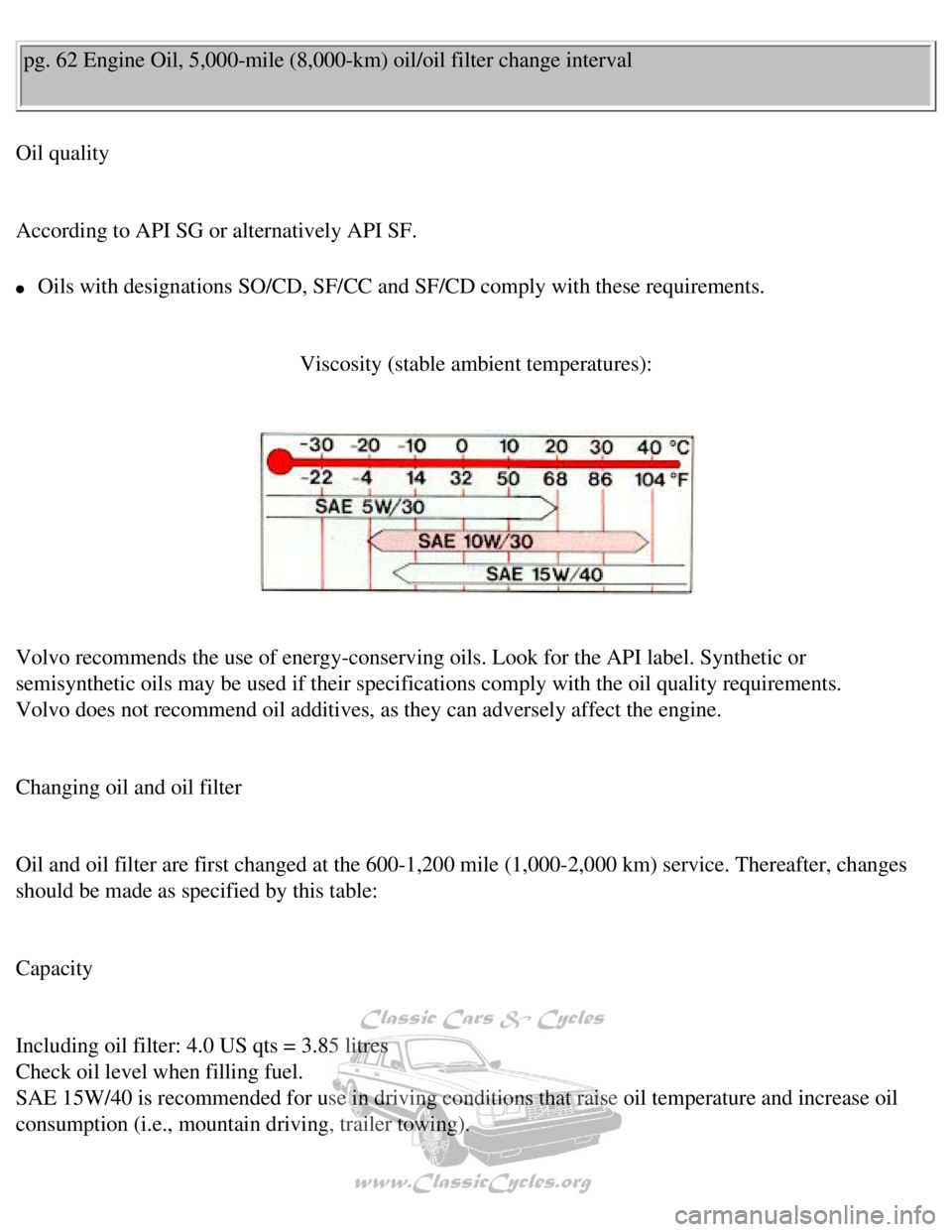
Volvo 1990 240 Model
pg. 62 Engine Oil, 5,000-mile (8,000-km) oil/oil filter change interva\
l
Oil quality
According to API SG or alternatively API SF.
l Oils with designations SO/CD, SF/CC and SF/CD comply with these requirem\
ents.
Viscosity (stable ambient temperatures):
Volvo recommends the use of energy-conserving oils. Look for the API lab\
el. Synthetic or
semisynthetic oils may be used if their specifications comply with the o\
il quality requirements.
Volvo does not recommend oil additives, as they can adversely affect the\
engine.
Changing oil and oil filter
Oil and oil filter are first changed at the 600-1,200 mile (1,000-2,000\
km) service. Thereafter, changes
should be made as specified by this table:
Capacity
Including oil filter: 4.0 US qts = 3.85 litres
Check oil level when filling fuel.
SAE 15W/40 is recommended for use in driving conditions that raise oil t\
emperature and increase oil
consumption (i.e., mountain driving, trailer towing).
file:///K|/ownersdocs/1990/1990_240/90240_13.htm (6 of 9)12/30/2006 8:\
25:08 AM
Page 93 of 143

Volvo 1990 240 Model
pg. 70 Manual transmission
Manual transmission with overdrive, M47 II
Capacity: 1.6 US qts 1.5 liters.
Fluid type: Automatic Transmission Fluid Type F
Replace: at 600-1,200 mile (1,000-2,000 km) service only.
The oil level should be up to the level/filler plug.
When replacing transmission oil, drain the oil immediately after driving\
, while it is still hot, by
removing the drain plug.
Warning: Use care to prevent possible burning from hot transmission
oil.
pg. 71 Automatic transmission
file:///K|/ownersdocs/1990/1990_240/90240_15.htm (1 of 10)12/30/2006 8\
:25:09 AM
Page 94 of 143
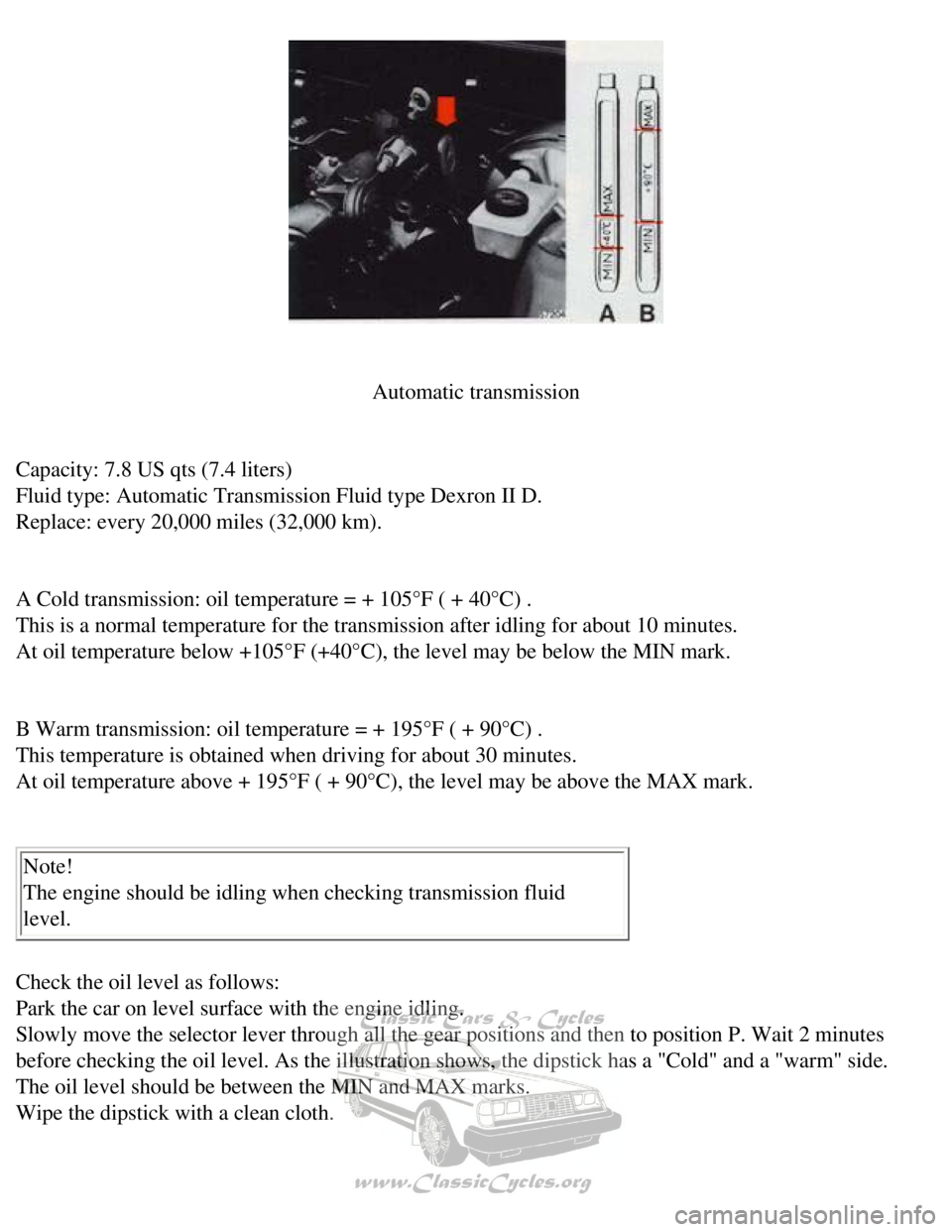
Volvo 1990 240 Model
Automatic transmission
Capacity: 7.8 US qts (7.4 liters)
Fluid type: Automatic Transmission Fluid type Dexron II D.
Replace: every 20,000 miles (32,000 km).
A Cold transmission: oil temperature = + 105°F ( + 40°C) .
This is a normal temperature for the transmission after idling for about\
10 minutes.
At oil temperature below +105°F (+40°C), the level may be below \
the MIN mark.
B Warm transmission: oil temperature = + 195°F ( + 90°C) .
This temperature is obtained when driving for about 30 minutes.
At oil temperature above + 195°F ( + 90°C), the level may be abo\
ve the MAX mark.
Note!
The engine should be idling when checking transmission fluid
level.
Check the oil level as follows:
Park the car on level surface with the engine idling.
Slowly move the selector lever through all the gear positions and then t\
o position P. Wait 2 minutes
before checking the oil level. As the illustration shows, the dipstick h\
as a "Cold" and a "warm" side.
The oil level should be between the MIN and MAX marks.
Wipe the dipstick with a clean cloth.
file:///K|/ownersdocs/1990/1990_240/90240_15.htm (2 of 10)12/30/2006 8\
:25:09 AM
Page 95 of 143
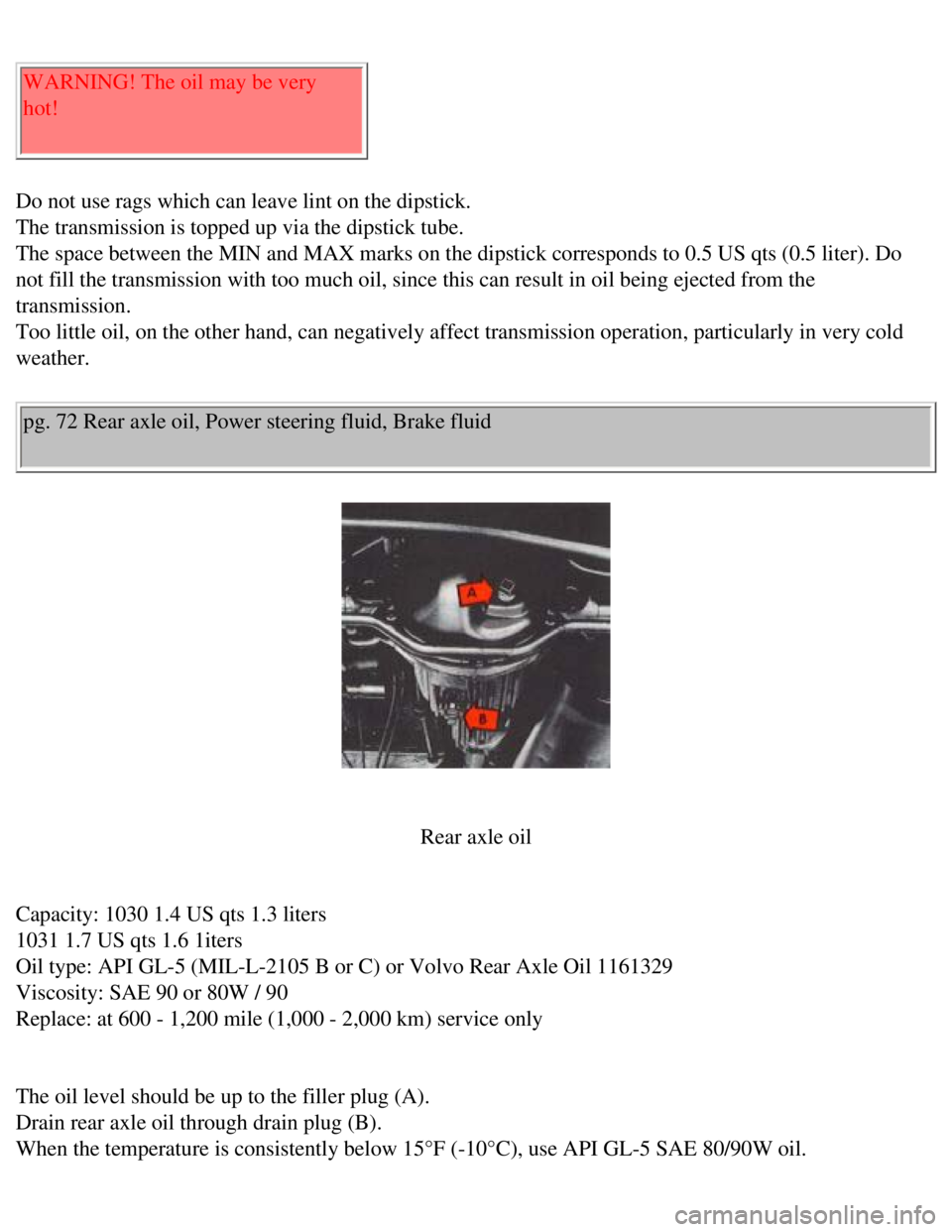
Volvo 1990 240 Model
WARNING! The oil may be very
hot!
Do not use rags which can leave lint on the dipstick.
The transmission is topped up via the dipstick tube.
The space between the MIN and MAX marks on the dipstick corresponds to 0\
.5 US qts (0.5 liter). Do
not fill the transmission with too much oil, since this can result in oi\
l being ejected from the
transmission.
Too little oil, on the other hand, can negatively affect transmission op\
eration, particularly in very cold
weather.
pg. 72 Rear axle oil, Power steering fluid, Brake fluid
Rear axle oil
Capacity: 1030 1.4 US qts 1.3 liters
1031 1.7 US qts 1.6 1iters
Oil type: API GL-5 (MIL-L-2105 B or C) or Volvo Rear Axle Oil 1161329 \
Viscosity: SAE 90 or 80W / 90
Replace: at 600 - 1,200 mile (1,000 - 2,000 km) service only
The oil level should be up to the filler plug (A).
Drain rear axle oil through drain plug (B).
When the temperature is consistently below 15°F (-10°C), use API\
GL-5 SAE 80/90W oil.
file:///K|/ownersdocs/1990/1990_240/90240_15.htm (3 of 10)12/30/2006 8\
:25:09 AM
Page 96 of 143
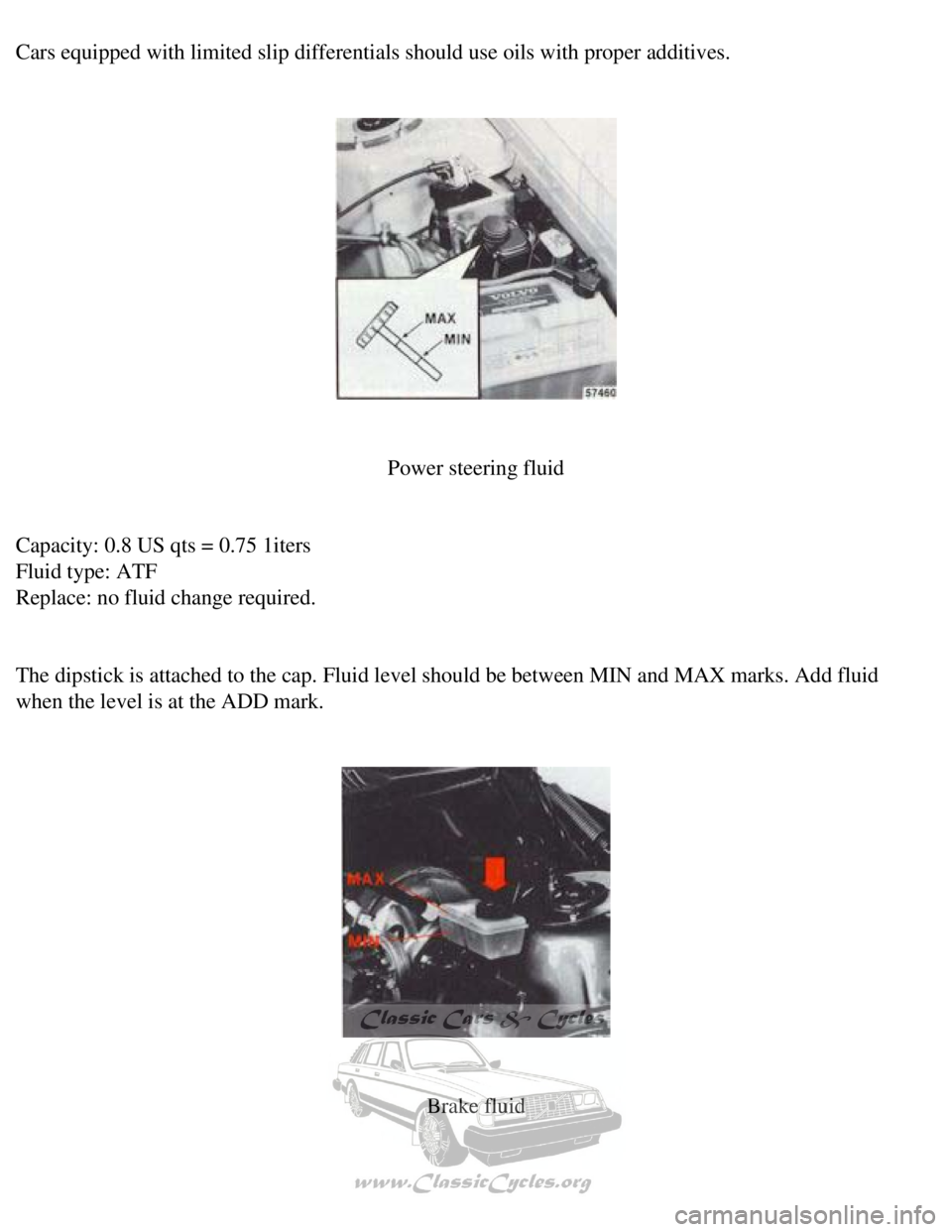
Volvo 1990 240 Model
Cars equipped with limited slip differentials should use oils with prope\
r additives.
Power steering fluid
Capacity: 0.8 US qts = 0.75 1iters
Fluid type: ATF
Replace: no fluid change required.
The dipstick is attached to the cap. Fluid level should be between MIN a\
nd MAX marks. Add fluid
when the level is at the ADD mark.
Brake fluid
file:///K|/ownersdocs/1990/1990_240/90240_15.htm (4 of 10)12/30/2006 8\
:25:09 AM
Page 124 of 143
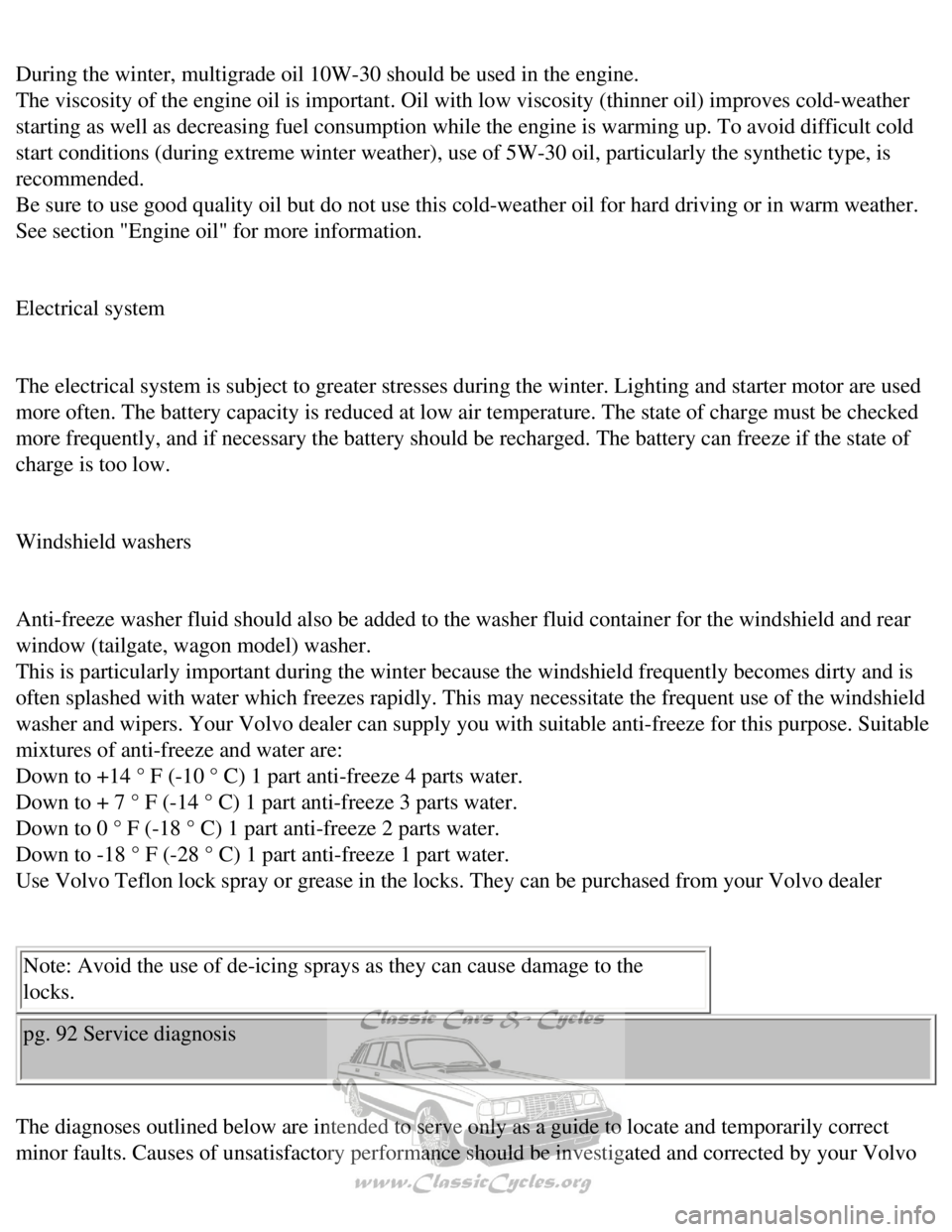
Volvo 1990 240 Model
During the winter, multigrade oil 10W-30 should be used in the engine. \
The viscosity of the engine oil is important. Oil with low viscosity (t\
hinner oil) improves cold-weather
starting as well as decreasing fuel consumption while the engine is warm\
ing up. To avoid difficult cold
start conditions (during extreme winter weather), use of 5W-30 oil, pa\
rticularly the synthetic type, is
recommended.
Be sure to use good quality oil but do not use this cold-weather oil for\
hard driving or in warm weather.
See section "Engine oil" for more information.
Electrical system
The electrical system is subject to greater stresses during the winter. \
Lighting and starter motor are used
more often. The battery capacity is reduced at low air temperature. The \
state of charge must be checked
more frequently, and if necessary the battery should be recharged. The b\
attery can freeze if the state of
charge is too low.
Windshield washers
Anti-freeze washer fluid should also be added to the washer fluid contai\
ner for the windshield and rear
window (tailgate, wagon model) washer.
This is particularly important during the winter because the windshield \
frequently becomes dirty and is
often splashed with water which freezes rapidly. This may necessitate th\
e frequent use of the windshield
washer and wipers. Your Volvo dealer can supply you with suitable anti-f\
reeze for this purpose. Suitable
mixtures of anti-freeze and water are:
Down to +14 ° F (-10 ° C) 1 part anti-freeze 4 parts water.
Down to + 7 ° F (-14 ° C) 1 part anti-freeze 3 parts water.
Down to 0 ° F (-18 ° C) 1 part anti-freeze 2 parts water.
Down to -18 ° F (-28 ° C) 1 part anti-freeze 1 part water.
Use Volvo Teflon lock spray or grease in the locks. They can be purchase\
d from your Volvo dealer
Note: Avoid the use of de-icing sprays as they can cause damage to the
locks.
pg. 92 Service diagnosis
The diagnoses outlined below are intended to serve only as a guide to lo\
cate and temporarily correct
minor faults. Causes of unsatisfactory performance should be investigate\
d and corrected by your Volvo
file:///K|/ownersdocs/1990/1990_240/90240_19.htm (2 of 7)12/30/2006 8:\
25:13 AM
Page 132 of 143
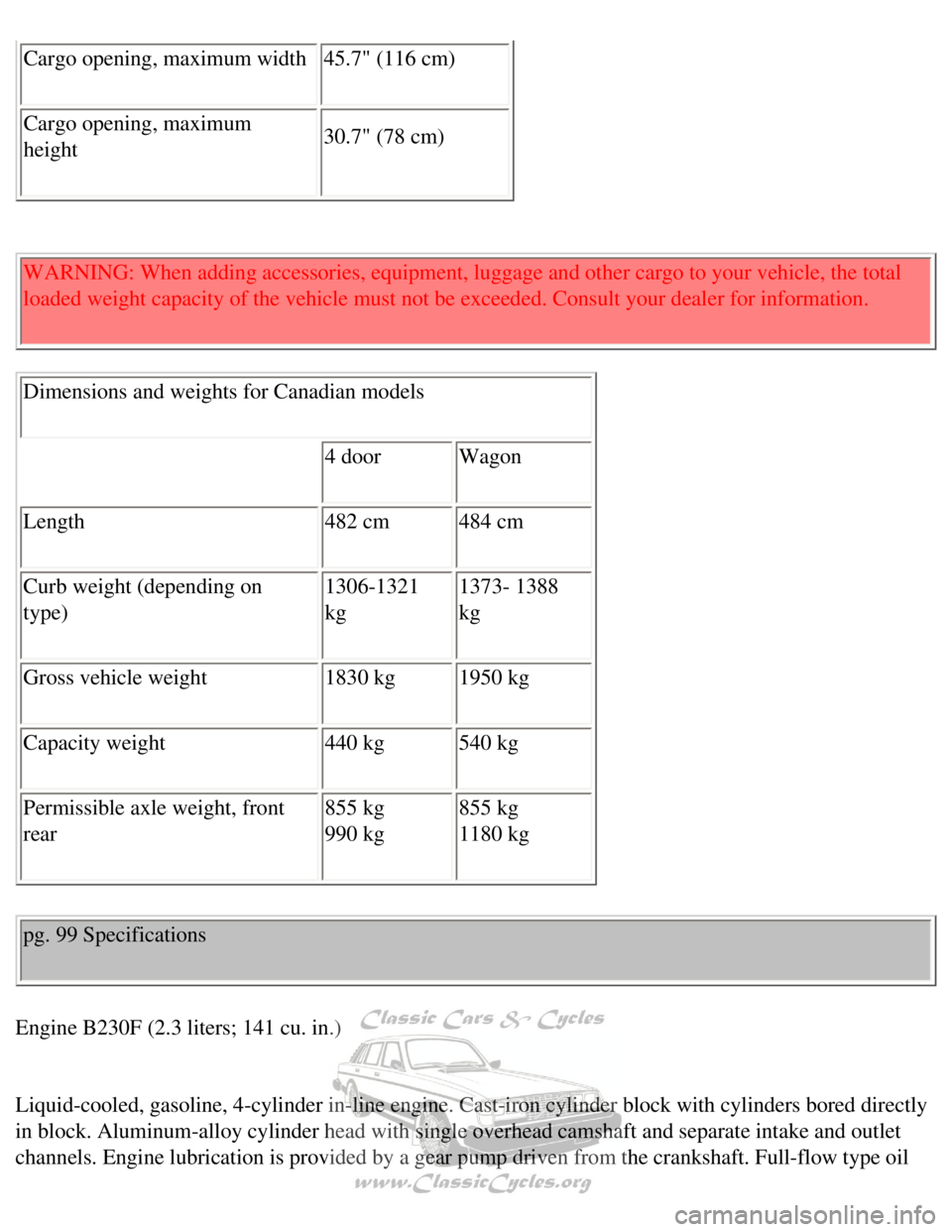
Volvo 1990 240 Model
Cargo opening, maximum width 45.7" (116 cm)
Cargo opening, maximum
height 30.7" (78 cm)
WARNING: When adding accessories, equipment, luggage and other cargo to \
your vehicle, the total
loaded weight capacity of the vehicle must not be exceeded. Consult your\
dealer for information.
Dimensions and weights for Canadian models
4 door Wagon
Length 482 cm 484 cm
Curb weight (depending on
type) 1306-1321
kg 1373- 1388
kg
Gross vehicle weight 1830 kg 1950 kg
Capacity weight 440 kg 540 kg
Permissible axle weight, front
rear 855 kg
990 kg 855 kg
1180 kg
pg. 99 Specifications
Engine B230F (2.3 liters; 141 cu. in.)
Liquid-cooled, gasoline, 4-cylinder in-line engine. Cast-iron cylinder b\
lock with cylinders bored directly
in block. Aluminum-alloy cylinder head with single overhead camshaft and\
separate intake and outlet
channels. Engine lubrication is provided by a gear pump driven from the \
crankshaft. Full-flow type oil
file:///K|/ownersdocs/1990/1990_240/90240_20.htm (3 of 14)12/30/2006 8\
:25:15 AM